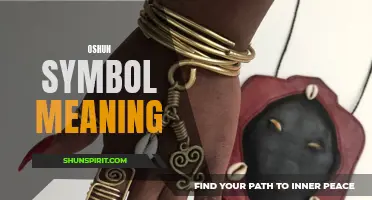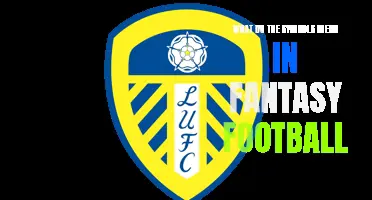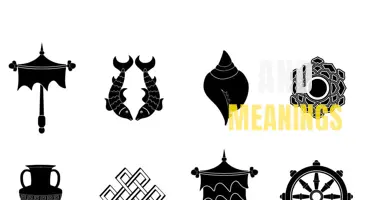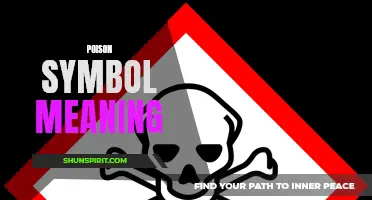
Masons, also known as Freemasons, have long been associated with secret symbols and mysterious rituals. These symbols hold deep meanings and are rich with symbolism that can often be misunderstood by those outside of the Masonic fraternity. From the iconic square and compass to the all-seeing eye, each symbol carries its own significance and adds to the rich tapestry of Masonic symbolism. Join us as we delve into the world of Masonic symbols and explore their hidden meanings.
What You'll Learn
- What is the meaning behind the square and compasses symbol used by Freemasons?
- How have the meanings and interpretations of Masonic symbols evolved over time?
- What are some other common symbols used by Freemasons and what do they represent?
- Are there different interpretations of Masonic symbols among different Masonic lodges or jurisdictions?
- How do Masonic symbols connect to the larger ritual and philosophical teachings of Freemasonry?

What is the meaning behind the square and compasses symbol used by Freemasons?
The square and compasses symbol is one of the most recognizable symbols associated with Freemasonry. It consists of a square and a set of compasses intertwined, often with a letter "G" in the center. This symbol has deep symbolism and significance within the Freemasonry fraternity.
The square represents morality, order, and virtue. It is a symbol used in construction to ensure accuracy and integrity. In Freemasonry, the square represents how one should conduct their actions in a just and upright manner. It reminds Freemasons to act honestly, fairly, and with integrity in their interactions with others. The square also represents the importance of balance and equality in life.
The compasses, on the other hand, represent self-control and restraint. Just as the compasses are used by architects to draw circles within certain boundaries, Freemasons are encouraged to control their desires and keep their passions within bounds. The compasses symbolize a Freemason's ability to keep their actions and emotions in check and maintain a well-rounded life.
The letter "G" in the center of the square and compasses symbol stands for "God" or "Great Architect of the Universe." It represents the belief in a higher power and the need for spiritual enlightenment. However, it is important to note that Freemasonry is a non-religious organization that welcomes members from various religious backgrounds. The letter "G" acknowledges the existence of a higher power and encourages members to seek moral and spiritual guidance in their lives.
The square and compasses symbol is often found on Masonic lodge buildings, documents, jewelry, and regalia. It serves as a reminder to Freemasons of the principles they strive to uphold and the moral lessons they have learned through their initiation and ritualistic ceremonies.
In addition to its symbolism, the square and compasses symbol also serves as a recognition marker among Freemasons. When visiting other lodges or meeting fellow Freemasons, the symbol can be used to identify one's membership and affiliation with the fraternity.
In conclusion, the square and compasses symbol used by Freemasons carries deep symbolism and significance. It represents the importance of morality, self-control, and the belief in a higher power. It serves as a reminder for Freemasons to conduct their actions with integrity and maintain balance in their lives. The symbol is not only a visual representation of the values upheld by Freemasonry but also a recognition marker among members of the fraternity.
Exploring the Intricate Symbolism and Meaning behind BDSM Symbols
You may want to see also

How have the meanings and interpretations of Masonic symbols evolved over time?
Symbols have always played an essential role in Freemasonry, with each symbol representing specific meanings and teachings. However, throughout history, the interpretations of Masonic symbols have evolved, adapting to the changing needs and beliefs of the society in which Freemasonry exists.
The origins of Masonic symbols can be traced back to the medieval stonemasons who formed guilds and associations to preserve their craft. These early symbols revolved around tools of the trade, such as the square, compass, plumb, and level, and were used to communicate knowledge and skills within the masonic community. As Freemasonry expanded beyond these operative roots to include non-stonemasons, these symbols began to acquire deeper symbolic meanings.
In the 18th century, when Freemasonry experienced a surge in popularity during the Age of Enlightenment, the meanings associated with Masonic symbols became more philosophical in nature. Symbols such as the all-seeing eye, the pillars of Jachin and Boaz, and the beehive came to represent enlightenment, wisdom, and the pursuit of knowledge. These symbols were believed to convey the teachings of moral and ethical principles to Freemasons, emphasizing the importance of personal growth and self-improvement.
During the 19th century, as Freemasonry spread across the globe, different cultures and societies began to interpret Masonic symbols according to their own traditions and beliefs. For example, in Europe, where Freemasonry was closely associated with the Enlightenment movement, symbols were often interpreted in a rational and intellectual manner. In contrast, in the United States, where the influence of Christianity was strong, symbols were often seen as representing moral and religious ideals.
In the latter half of the 20th century, with the decline of membership in many Masonic lodges, there was a shift in the interpretation of Masonic symbols. Some Masonic scholars and historians began to argue for a return to the original meanings of the symbols, emphasizing their practical and allegorical significance rather than mystical or esoteric interpretations. This shift aimed to make Freemasonry more accessible and relevant to modern society, highlighting the practical application of its teachings.
Today, the meanings and interpretations of Masonic symbols continue to evolve, reflecting the changing beliefs and values of contemporary Freemasons. While the tools of the trade still hold a place in Masonic symbolism, newer symbols like the hourglass, the trowel, and the blazing star have gained prominence, representing concepts such as the finite nature of life, the spreading of fraternal love, and the pursuit of divine truth.
In conclusion, the meanings and interpretations of Masonic symbols have evolved over time, adapting to the needs and beliefs of the society in which Freemasonry exists. From practical tools to philosophical and moral ideals, Masonic symbols continue to convey teachings and values that aim to guide Freemasons in their personal and spiritual journeys. Whether interpreted in a rational, intellectual, or symbolic manner, these symbols serve as reminders of the timeless principles that Freemasonry seeks to uphold.
Exploring the Rich Symbolism and Meanings of Italian Family Traditions and Symbols
You may want to see also

What are some other common symbols used by Freemasons and what do they represent?
Freemasonry is a secretive society that has long fascinated people around the world. One aspect of Freemasonry that has received a lot of attention is its use of symbols. These symbols have deep meanings and represent various concepts and ideals that Freemasons hold dear. While there are many symbols used by Freemasons, let's explore some of the most common ones and what they represent.
The Square and Compasses is perhaps the most recognizable symbol of Freemasonry. The square represents morality and fairness, reminding Freemasons to be upright in their dealings with others. The compasses, on the other hand, represent discipline and self-control, reminding Freemasons to keep their passions in check. Together, the square and compasses symbolize the importance of living a balanced and virtuous life.
The All-Seeing Eye, often depicted as a single eye within a triangle, is another symbol commonly associated with Freemasonry. This symbol represents the watchful eye of God, who sees and knows everything. It reminds Freemasons to always act with integrity and not to forget that their actions are being observed by a higher power.
The Three Great Lights are three essential tools that Freemasons use in their rituals and symbolic teachings. These include the Square, Compass, and Volume of Sacred Law (usually the Bible). The Square represents morality, the Compass represents virtue, and the Volume of Sacred Law represents divine guidance. These three lights act as guiding principles for Freemasons, reminding them of the importance of living by moral principles and seeking divine wisdom.
The Pillars, often depicted as two columns known as Boaz and Jachin, are commonly found in Freemasonry symbolism. These pillars represent strength and stability, both physical and moral. They remind Freemasons of the importance of building their lives on a solid foundation of truth and righteousness.
The Five-Pointed Star, also known as the Blazing Star, is another symbol used by Freemasons. This star represents divine light and knowledge. It serves as a reminder for Freemasons to seek enlightenment and to continually strive for knowledge.
The Square and the Level are tools commonly found in Freemasonry symbolism. The Square represents equality and fairness, reminding Freemasons to treat all individuals as equals and to judge people based on their character and actions rather than their social status. The Level, on the other hand, represents humility and reminds Freemasons to keep themselves grounded and to never think of themselves as superior to others.
These are just a few examples of the many symbols used by Freemasons. Each symbol carries its own unique meaning and serves as a reminder for Freemasons of the principles and ideals that they hold dear. These symbols play a significant role in Freemasonry rituals and teachings, helping members to better understand and internalize the lessons and values of the society. While the meanings behind the symbols may be known to Freemasons, they often remain a mystery to those outside of the society, adding to the intrigue and fascination surrounding Freemasonry.
The Hidden Symbolic Meaning of Silver: Unveiling its Mysteries
You may want to see also

Are there different interpretations of Masonic symbols among different Masonic lodges or jurisdictions?
Masonic symbols have long been a source of fascination and intrigue for both Freemasons and non-members alike. These symbols are rich in history and tradition and carry deep meaning within the fraternity. However, the interpretation of these symbols can vary among different Masonic lodges or jurisdictions.
One of the reasons for these differences in interpretation is the diversity of Masonic rituals and traditions across the world. Freemasonry is a global fraternity that has lodges in numerous countries, each with its own unique practices and customs. This means that symbols may be understood differently depending on where the lodge is located.
For example, the square and compass is one of the most recognizable Masonic symbols. It represents morality and the importance of living a balanced and truthful life. However, the exact meaning and significance of this symbol may vary among different lodges. Some jurisdictions may place a greater emphasis on the moral teachings of the symbol, while others may focus more on the balance and harmony it represents.
Furthermore, different interpretations of symbols can also arise due to the individual experiences and beliefs of Freemasons. Each Mason brings their own perspective and understanding to the symbols, which can lead to variations in interpretation. This diversity of thought is a key aspect of Freemasonry, as it encourages members to seek knowledge and understanding through their own personal journey.
In addition, the interpretation of symbols may also evolve over time. As societies change and new ideas emerge, Freemasonry adapts to reflect these changes. This means that symbols that were once understood in a certain way may come to be seen differently in the modern era. This can lead to differences in interpretation among different generations of Freemasons.
It is also worth noting that while there may be differences in interpretation, there are also many commonalities among Masonic lodges and jurisdictions. The fundamental principles and values of Freemasonry remain consistent, and the symbols are generally understood to represent these timeless teachings. Masonic rituals and ceremonies are designed to impart these teachings to members, regardless of any variations in interpretation.
In conclusion, there are indeed different interpretations of Masonic symbols among different Masonic lodges or jurisdictions. These differences can arise due to the diversity of Masonic rituals, personal experiences and beliefs of Freemasons, and the evolution of society. However, despite these variations, the core values and teachings behind the symbols remain consistent across the fraternity.
Unlocking the Meaning of the Anchor Symbol in Love: A Symbol of Stability and Security
You may want to see also

How do Masonic symbols connect to the larger ritual and philosophical teachings of Freemasonry?
Freemasonry is a secretive society that has been surrounded by mystery and conspiracy theories for centuries. One of the most distinctive aspects of Freemasonry is its use of symbols. These symbols, such as the square and compass, the all-seeing eye, and the pillars, play a central role in Masonic rituals and teachings. They are believed to contain hidden meanings and serve as a reminder to Masons of the values and principles they should strive to embody.
The square and compass symbol is perhaps the most recognizable Masonic symbol. It consists of a square and a set of compasses intertwined, with a letter "G" in the middle. The square represents morality, specifically the importance of truth, fairness, and integrity in one's actions. The compasses symbolize the importance of self-control and the ability to restrain one's passions and desires. The letter "G" stands for God or the Great Architect of the Universe, and represents the divine presence that Masons believe exists in the world.
The all-seeing eye, also known as the Eye of Providence, is another prominent Masonic symbol. It is often depicted as an eye inside a triangle and is believed to represent the watchful eye of God, who sees and judges all actions. The eye serves as a reminder to Masons that their actions are always being observed and that they should strive to lead a virtuous life.
The pillars, known as Boaz and Jachin, are two other important symbols in Freemasonry. They are believed to represent the pillars that stood in front of the Temple of Solomon in ancient Jerusalem. The pillar of Boaz symbolizes strength, stability, and wisdom, while the pillar of Jachin represents establishment, establishment, and equilibrium. Together, they remind Masons of the importance of balance and harmony in their thoughts, words, and actions.
These symbols, along with many others, are used throughout Masonic rituals and ceremonies to convey important lessons and teachings. Each symbol is accompanied by a deeper meaning and is often explained to Masons during their initiation into the fraternity. The symbols act as visual aids, helping to reinforce the lessons being taught and encouraging Masons to reflect on their own behavior and character.
In addition to their use in rituals, Masonic symbols also serve as a means of identification among Freemasons. Because the society is secretive, members use symbols to recognize one another and establish trust. The symbols act as a sort of language, allowing Masons to communicate with one another without revealing their membership to outsiders.
Overall, Masonic symbols are a key part of Freemasonry and its teachings. They serve as a visual representation of the values and principles that Masons strive to uphold. Through their use in rituals and ceremonies, these symbols help Masons deepen their understanding of the philosophical and moral teachings of the fraternity. They also serve as a means of identification and communication among members. While the true meanings of the symbols may remain a mystery to non-Masons, they are a source of inspiration and guidance for those within the fraternity.
The Hidden Meanings Behind Zelda Symbols Unveiled
You may want to see also
Frequently asked questions
The Masons symbol, often referred to as the Square and Compass, is a widely recognized symbol associated with Freemasonry. It is said to represent the moral and spiritual teachings of the Masonic fraternity, emphasizing the importance of living a balanced life and adhering to principles of morality and ethics.
The square and compass are two essential tools used in Masonry. The square represents fairness and truth, symbolizing the importance of honesty and integrity in all actions. The compass represents knowledge and judgment, representing the need for self-discipline and the ability to make wise decisions.
The Masons symbol itself is not affiliated with any particular religious belief. Freemasonry is a fraternity that accepts individuals from different religious backgrounds and encourages them to practice their own faith while upholding the principles of Masonry. The square and compass symbol represents moral and ethical principles rather than specific religious teachings.







